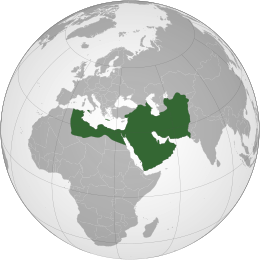More languages
More actions
| Abbasid Caliphate الْخِلَافَةُ الْعَبَّاسِيَّة | |
|---|---|
| 750–1517 | |
|
Flag | |
 The Abbasid Caliphate in 850 | |
| Capital | Baghdad |
| Official languages | Arabic |
| Religion | Islam |
| Government | Monarchy |
The Abbasid Caliphate was the third Islamic caliphate. It was threatened by secessions of its outer regions as well as coup attempts by factions of the ruling class and the possibility of a social revolution.[1]
History[edit | edit source]
Foundation[edit | edit source]
Abu al-Abbas built an underground network of supporters and organized a revolution against the Umayyad Caliphate. Power passed to a larger ruling class and Arab ethnicity lost its significance.[1]
Decline[edit | edit source]
During the ninth and tenth centuries, the Abbasids faced the rival Fatimid dynasty in Cairo and successors of the Umayyads in Spain. These conflicts weakened the Caliphate and drained its resources. Pope Urban called for a crusade against the weakened Umayyads in 1095.[1]
Government[edit | edit source]
The Abbasid government was unpopular and its population was divided among many ethnic groups. They had to pay high taxes to fund palaces and the military.[1]
Military[edit | edit source]
The Abbasids replaced their traditional army with Turkic mercenaries from Central Asia. The Turks later seized power for themselves.[1]
References[edit | edit source]
- ↑ 1.0 1.1 1.2 1.3 1.4 Neil Faulkner (2013). A Marxist History of the World: From Neanderthals to Neoliberals: 'The Medieval World' (pp. 62–63). [PDF] Pluto Press. ISBN 9781849648639 [LG]

